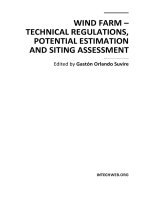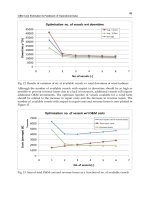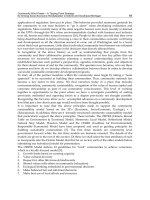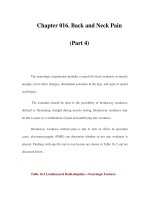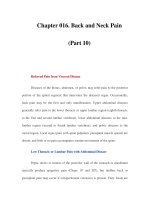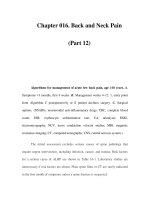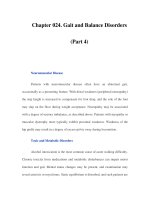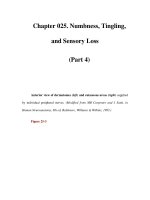Chapter 072. Malnutrition and Nutritional Assessment (Part 4) pdf
Bạn đang xem bản rút gọn của tài liệu. Xem và tải ngay bản đầy đủ của tài liệu tại đây (11.55 KB, 5 trang )
Chapter 072. Malnutrition and
Nutritional Assessment
(Part 4)
Protein Catabolism
The rate of endogenous protein breakdown (catabolism) to supply energy
needs normally falls during uncomplicated energy deprivation. After about 10
days of total starvation, the unstressed individual loses about 12–18 g/d protein
(equivalent to approximately 2 oz of muscle tissue or 2–3 g of nitrogen). By
contrast, in injury and sepsis, protein breakdown accelerates in proportion to the
degree of stress, to 30–60 g/d after elective surgery, 60–90 g/d with infection,
100–130 g/d with severe sepsis or skeletal trauma, and >175 g/d with major burns
or head injuries. These losses are reflected by proportional increases in the
excretion of urea nitrogen, the major byproduct of protein breakdown.
Gluconeogenesis
The major aim of protein catabolism during a state of starvation is to
provide the glucogenic amino acids (especially alanine and glutamine) that serve
as substrates for endogenous glucose production (gluconeogenesis) in the liver. In
the hypometabolic/starved state, protein breakdown for gluconeogenesis is
minimized, especially as ketones derived from fatty acids become the substrate
preferred by certain tissues. In the hypermetabolic/stress state, gluconeogenesis
increases dramatically and in proportion to the degree of the insult, to increase the
supply of glucose (the major fuel of reparation). Glucose is the only fuel that can
be utilized by hypoxic tissues (anaerobic glycolysis), white blood cells, and newly
generated fibroblasts. Infusions of glucose partially offset a negative energy
balance but do not significantly suppress the high rates of gluconeogenesis in the
catabolic patient. Hence, adequate supplies of protein are needed to replace the
amino acids utilized for this metabolic response.
In summary, the hypometabolic patient is adapted to starvation and
conserves body mass by reducing the metabolic rate and using fat as the primary
fuel (rather than glucose and its precursor amino acids). The hypermetabolic
patient also uses fat as a fuel but rapidly breaks down body protein to produce
glucose, causing loss of muscle and organ tissue and endangering vital body
functions.
Micronutrient Malnutrition
The same illnesses and reductions in nutrient intake that lead to PEM often
produce deficiencies of vitamins and minerals as well (Chap. 71). Deficiencies of
nutrients that are stored in small amounts (such as the water-soluble vitamins) are
lost through external secretions, such as zinc in diarrhea fluid or burn exudate, and
are probably more common than generally recognized.
Deficiencies of vitamin C, folic acid, and zinc are reasonably common in
sick patients. Signs of scurvy such as corkscrew hairs on the lower extremities are
frequently found in chronically ill and/or alcoholic patients. The diagnosis can be
confirmed with plasma vitamin C levels. Folic acid intakes and blood levels are
often less than optimal, even among healthy persons; when illness, alcoholism,
poverty, or poor dentition is present, deficiencies are common. Low blood zinc
levels are prevalent in patients with malabsorption syndromes such as
inflammatory bowel disease. Patients with zinc deficiency often exhibit poor
wound healing, pressure ulcer formation, and impaired immunity. Thiamine
deficiency is a common complication of alcoholism, but its manifestations are
often prevented by therapeutic doses of thiamine in patients treated for alcohol
abuse.
Patients with low plasma vitamin C levels usually respond to the doses
found in multivitamin preparations, but patients with deficiencies should be
supplemented with 250–500 mg/d. Folic acid is absent from some oral
multivitamin preparations; patients with deficiencies should be supplemented with
about 1 mg/d. Patients with zinc deficiencies resulting from large external losses
sometimes require oral daily supplementation with 220 mg of zinc sulfate one to
three times daily. For these reasons, laboratory assessments of the micronutrient
status of patients at high risk are desirable.
Hypophosphatemia develops in hospitalized patients with remarkable
frequency and generally results from rapid intracellular shifts of phosphate in
cachectic or alcoholic patients receiving intravenous glucose (Chap. 46). The
adverse clinical sequelae are numerous; some, such as acute cardiopulmonary
failure, can be life-threatening.
Nutritional Assessment
Because interactions between illness and nutrition are complex, many
physical and laboratory findings reflect both underlying disease and nutritional
status. Therefore, the nutritional evaluation of a patient requires an integration of
the history, physical examination, anthropometrics, and laboratory studies. This
approach helps both to detect nutritional problems and to avoid concluding that
isolated findings indicate nutritional problems when they do not. For example,
hypoalbuminemia caused by an underlying illness does not necessarily indicate
malnutrition.


